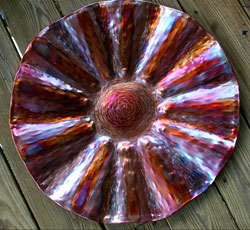Inspired by the Past: The Copper Art of Annie Keifert
 22" RAKU fired "sun" platter in opal moonglow colors. Wired to hang flat against the wall. Has raised domes around the center.
22" RAKU fired "sun" platter in opal moonglow colors. Wired to hang flat against the wall. Has raised domes around the center.Photograph courtesy of Annie Keifert
Inspired by early copper works of the Native Americans, artist Annie Keifert brings new life to a primitive style of Native American metalmaking.
For Keifert, it all began when she discovered the copper roots of Jameson, Virginia, where she traces her family's lineage. Back in the early 17th Century when the English settlers first arrived to the area, they came bearing sheets of rolled copper, which were then introduced to the Native American Indians. Keifert began studying this unique style of early Native American copper art and today continues this tradition with her contemporary metalworks.
Kieferts foray into copper arts began in the mid-1990s, when she was living in Arizona. She noticed that a workman installing air conditioning at her home had a 1x3 foot piece of sheet copper in his truck. Though she had never formally worked with the material, she demanded to buy the copper, and her career began.
Before long, Kiefert became fascinated by the Native American coppersmithing from the Piedmont region of Virginia, where she traces her family's lineage. Today, she's making art, sculpture and functional objects inspired by that early work: Large colorful plates and bowls, woven copper baskets, along with children's toys and finials, or caps, for rooftops in the Washington D.C. area, where she sells her wares at the Eastern Market on Capitol Hill.
"My basic platters use patterns from the Jamestown era," she said. "My more artistic pieces often have a cosmic appeal, a Milky Way scientist, Hubble telescope kind of thing. I hammer out domes and bowls that look like craters."
 Finished custom 3ft x 5ft "wave" copper wall sculpture. Wired to hang all ways.
Finished custom 3ft x 5ft "wave" copper wall sculpture. Wired to hang all ways. Photograph courtesy of Annie Keifert
In the beginning, Keifert spent years digging through scrap yards for bits of copper, but today she simply buys it on eBay. To make one of her signature platters, she gets a 4x10 foot copper sheet, strips it of all its oils, and hand burnishes it with fine steel wool. Working on a concrete floor, she then hammers lines on one side with an auto-body hammer, then flips and hammers the other side, in the opposite areas. Then she heats the piece until it glows red, and repeats the process.
Sometimes Keifert uses a torch to paint designs on her work, and she often relies on Raku firing techniques, which involve removing a piece from the heat source at its maximum temperature. The rapid cooling creates wild designs on the copper surface.
In recent years Kiefert has become increasingly interested in the anti-microbial properties of copper, which has prompted her to develop crude copper children's toys made from stringing old pennies with holes bored in them onto bits of grounding wire. Laboratory testing has shown that when copper interacts with certain bacterium*, it compromises the cellular structure of those strains, killing them and neutralizing their potential as pathogens. Kiefert believes that her toys act as intrinsic anti-bacterial agents for the children who play with them, reducing their chances of contracting bacteria that cause communicable diseases.
"I do consultations on how to incorporate copper to daily touch surfaces, like hand rails, door push plates and even over deck railings," she says, noting that so long as copper isn't sealed or lacquered in any way, its anti-microbial properties remain effective.
Resources:
Also in this Issue:
- A Reverence for Copper and the Slower Melt of Time
- Robert Arneson: Self-Portraits in Bronze
- Kiln Design: Old School in the Natural World
- Studio 78: Artistic And Functional Hand Painted Furniture Enhanced with Copper
- Inspired by the Past: The Copper Art of Annie Keifert
